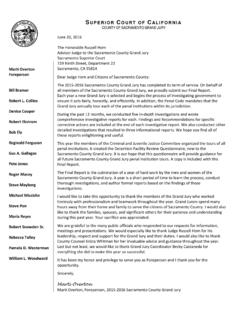Transcription of Salinas Valley State Prison (SVSP) Health Care …
1 Salinas Valley State Prison ( svsp ) Health care evaluation August 23, 2013 Prepared by the Plata Medical Experts Joe Goldenson MD Madie LaMarre MN, FNP-BC Mike Puisis DO Case3:01-cv-01351-TEH Document2704 Filed08/23/13 Page1 of 106 August 2013 Salinas Valley State Prison Page 2 Table of Contents Introduction .. 3 Overall Finding .. 5 Executive Summary .. 5 Findings .. 7 Facility Description .. 7 Organizational Structure and Health care Leadership .. 7 Human Resources, Staffing and Budget .. 10 Health care Operations, Clinic Space and Sanitation .. 20 Policies and Procedures .. 22 Intrasystem Transfer .. 24 Access to care .. 28 Chronic Disease Management .. 35 Urgent/Emergent 61 Specialty Services/Consultations.
2 74 Correctional Treatment Center care (CTC) .. 81 Mortality Review .. 90 Internal Monitoring and Quality Improvement Activities .. 101 Recommendations .. 103 Case3:01-cv-01351-TEH Document2704 Filed08/23/13 Page2 of 106 August 2013 Salinas Valley State Prison Page 3 Introduction In September 2012, the Federal Court, in Order Re: Receivership Transition Plan and Expert Evaluations requested that the Court medical experts conduct evaluations at each CDCR Prison to determine whether an institution is in substantial compliance. The Order contemplates that an institution shall be deemed to be in substantial compliance, and therefore constitutionally adequate, if it receives an overall OIG score of at least 75% and an evaluation from at least two of the three court experts that the institution is providing adequate care .
3 To prepare for the Prison Health evaluations, in December 2012 the medical experts participated in a series of meetings with Clark Kelso, Receiver, and California Correctional Health care Services (CCHCS) and CDCR leadership to familiarize ourselves with structural changes that have occurred in the Health care system since the beginning of the Receivership. Information gained from these meetings was invaluable to us in planning and performing the evaluations, and we express our appreciation to Mr. Kelso, CCHCS and CDCR. In conducting the reviews, the medical experts evaluated essential components to an adequate Health care system. These include organizational structure, Health care infrastructure ( , clinical space, equipment, etc.)
4 , Health care processes and the quality of care . Methods of assessment included: Interviews with Health care leadership and staff and custody staff; Tours and inspection of medical clinics, medical bed space ( Outpatient Housing Units, Correctional Treatment Centers, etc.) and administrative segregation units; Review of the functionality of business processes essential to administer a Health care system ( , budget, purchasing, human resources, etc.); Reviews of tracking logs and Health records; Observation of Health care processes ( medication administration); Review of policies and procedures and disease treatment guidelines; Review of staffing patterns and professional licensure; and Interviews with inmates.
5 With respect to the assessment of compliance, the medical experts seek to determine whether any pattern or practice exists at an institution or system wide that presents a serious risk of harm to inmates that is not being adequately To evaluate whether there is any pattern or practice that presents a serious risk of harm to CDCR patients, our methodology includes review of Health records of patients with serious 1 Order re: Receivership Transition Plan and Expert Evaluations No. C01 1351 TEH, 9/5/12. Case3:01-cv-01351-TEH Document2704 Filed08/23/13 Page3 of 106 August 2013 Salinas Valley State Prison Page 4 medical conditions using a tracer methodology.
6 Tracer methodology is a systems approach to evaluation that is used by the Joint Commission for Accreditation of Health care Organizations. The reviewer traces the patient through the organization s entire Health care process to identify whether there are performance issues in one or more steps of the process, or in the interfaces between processes. The experts reviewed records using this methodology to assess whether patients were receiving timely and appropriate care , and if not, what factors contributed to deficiencies in care . Review of any given record may show performance issues with several Health care processes ( , medical reception, chronic disease program, medication issues, etc.). Conversely, review of a particular record may demonstrate a well coordinated and functioning Health care system; as more records are reviewed, patterns of care emerge.
7 We selected records of patients with chronic diseases and other serious medical conditions because these are the patients at risk of harm and who use the Health care system most regularly. The care documented in these records will demonstrate whether there is an adequate Health care system. The tracer methodology may also reflect whether any system wide issues exist. Our methodology includes a reassessment of the systemic issues that were described in the medical experts report to Judge Henderson in April 2006 at the time the system was found to be unconstitutional and whether those systemic issues have been adequately We are available to discuss any questions regarding our audit methodology. 2 The Status of Health care Delivery Services in CDCR Facilities.
8 Court Appointed Medical Experts Report. April 15, 2006. Case3:01-cv-01351-TEH Document2704 Filed08/23/13 Page4 of 106 August 2013 Salinas Valley State Prison Page 5 Overall Finding We find that Salinas Valley State Prison ( svsp ) is not providing adequate medical care to patients, and that there are systemic issues that present an on going serious risk of harm to patients and result in preventable morbidity and mortality. Executive Summary On June 4 8, 2013, the Plata Court Medical Experts visited Salinas Valley State Prison ( svsp ) to evaluate Health care services. Our visit was in response to the OIG Medical Inspection Results, Cycle 3 report showing that svsp had an overall score of in December 2012. This report describes our findings and recommendations.
9 We thank Warden Randy Grounds, Chief Executive Officer Charles Young and their staff for their assistance and cooperation in conducting the review. At svsp , we found serious problems related to access, timeliness, and quality of care . Clinical systems that we found to be deficient included the intrasystem transfer process, nursing sick call, chronic disease management, urgent/emergent care , specialty services, and medication administration. The most significant concern related to access to care was quality of provider evaluations and delays in care for routine and urgent consultations. Delays in patient evaluations resulted in deterioration and unnecessary hospitalizations. We note that CCHCS quality data reports indicate that svsp had 50% more preventable hospitalizations than the State wide average.
10 We found serious problems with the intrasystem transfer process in terms of continuity of care . In addition, following arrival at svsp , medical care was often fragmented and of poor quality. Nurses did not consistently document vital signs and weight for patients with chronic diseases and pharmacy staff renewed medication orders from the sending facility without review and signature by an svsp provider. Furthermore, nursing referrals often did not occur timely and the provider s initial evaluations were often cursory. Physicians discontinued medications without clinically evaluating or discussing treatment changes with the patient. We found significant problems with management of chronic disease patients related to the timeliness and quality of care .






